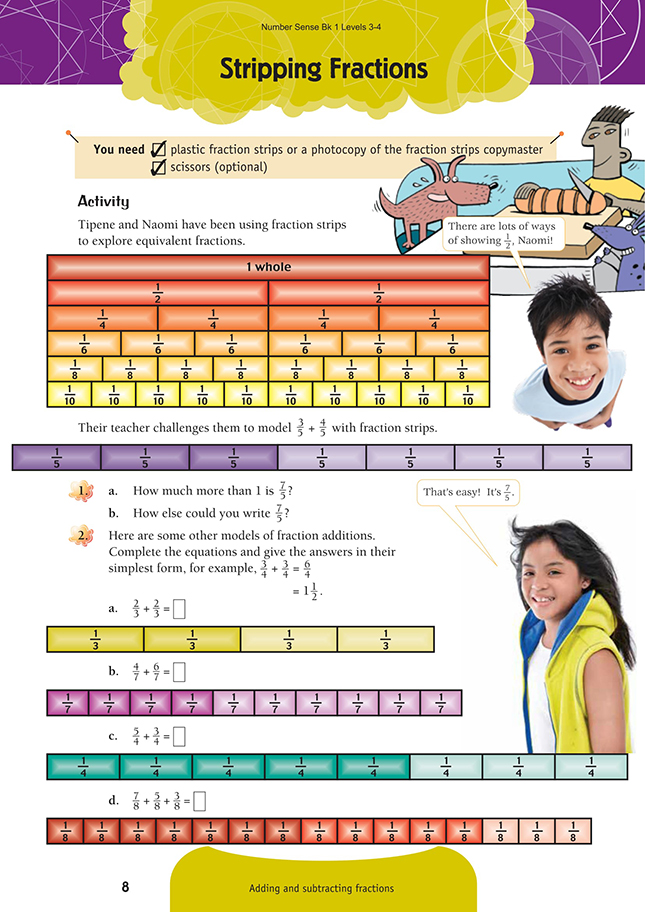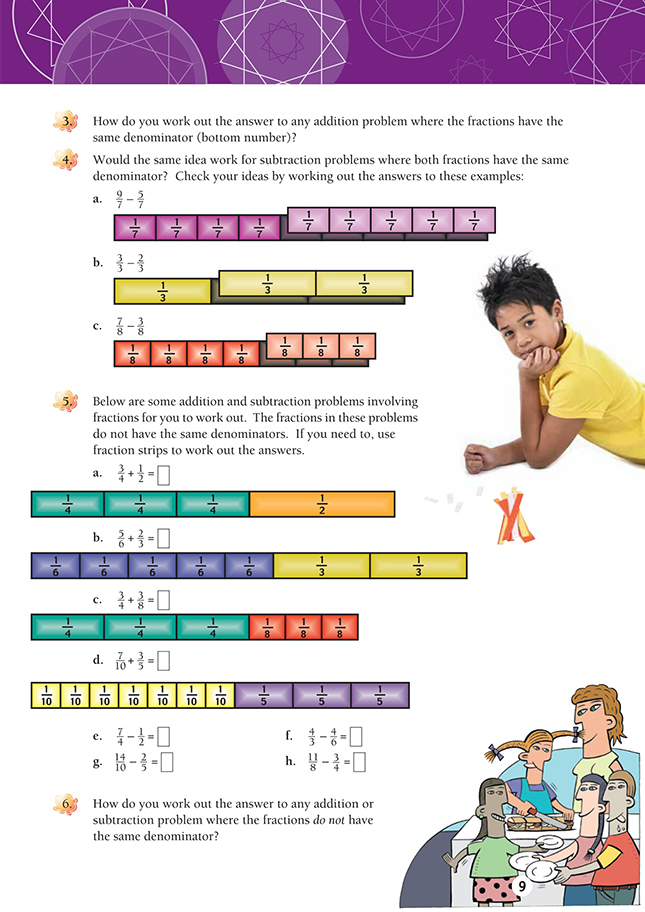This is a level 4 number activity from the Figure It Out series. It relates to Stage 7 of the Number Framework.
Click on the image to enlarge it. Click again to close. Download PDF (627 KB)
add and subtract related fractions
Number Framework Links
Use this activity to:
- help students to use advanced additive strategies (stage 6) or advanced multiplicative strategies (stage 7)
- encourage transition to advanced proportional strategies (stage 8). The activity is appropriate for these levels because it requires an understanding of equivalent fractions.
- Plastic Fraction Strips or Copymaster of Fraction Strips
- FIO, Levels 3-4, Number Sense and Algebraic Thinking, Book One, Stripping Fractions, pages 8-9
- Scissors (optional)
Questions 1–4 in this activity involve adding and subtracting fractions, including improper fractions (that is, fractions in which the numerator is equal to or greater than the denominator, for example, 7/5). The students need to be able to rename improper fractions as mixed numerals (for example, 3/2 as 1 1/2). The key to these operations is understanding equivalent fractions.
If addition and subtraction of fractions is taught before multiplicative understanding is established, students tend to develop misconceptions, often naively transferring rules for whole numbers to fractions. Common errors include:
• adding denominators as well as numerators, for example,
• ordering fractions by the “gap” between the denominator and numerator, for example, thinking that 3/5 is greater than 3/4 because 5 – 3 = 2 (for 3/5) is greater than 4 – 3 = 1 (for 3/4).
Equivalent fractions can be taught by building up or splitting. Building up involves using materials to make a given fraction and looking for patterns in those fractions that have equal parts. For example, building up 3/4 might establish 6/8, 9/12, and 13/16 as equivalent fractions. You could invite the students to look for patterns. This should lead to the observation that there is a multiplicative connection between such fractions, for example:
The denominator and numerator are both multiplied by 3.
Finding equivalent fractions by splitting involves taking a fraction, splitting it into a given number of equal parts, and finding the size of each part. For example, 1 whole split into thirds:
Then 1/3 cut into quarters gives 4/12.
This requires the students to use whole-to-part and part-to-whole reasoning. Mapping back to 1 (whole) is difficult for students who don’t have multiplicative understanding.
This activity uses fraction strips for adding and subtracting fractions. Fraction strips can be purchased commercially, or the students can make their own paper versions using the Numeracy Project (Material Master 7-7 )or the
copymaster at the end of these notes.
Before the students attempt the activity, establish the principle that fractions are made up of duplications (repeats) of a unit fraction. (A unit fraction is a fraction that has a numerator of 1.) For example, 4/5 = 1/5 + 1/5 + 1/5 + 1/5 , that is, 4 lots of 1/5. Once they understand this principle, the students can understand that when fractions with the same denominators are joined, the answer is always in terms of duplications of the unit fraction. For example, 3/8 + 6/8 = 9/8 is just 3 + 6 in lots of 1/8 and is
structurally identical to 300 + 600 = 900. The same principle holds true for subtraction, for example, 4/5 – 2/5 is 4 – 2 in lots of 1/5 , giving the answer 2/5.
Matters become more complicated where the fractions have different denominators because the unit fractions that make up the fractions are different sizes (see questions 5 and 6). Sometimes the unit fractions are closely related, like halves and quarters, thirds and ninths (where one is a multiple of the other). This makes the task of converting both fractions to equivalent forms with the same denominator much easier. For example, for 7/10 + 3/5, the 3/5 can be converted to 6/10, so the problem
becomes 7/10 + 6/10 = 13/10, which is 1 3/10.
Where the fractions being added or subtracted have unrelated denominators (that is, one is not a multiple of the other), both fractions need to be converted to equivalent fractions with a common denominator. The easiest denominator to use in converting the fractions is the lowest common multiple of the fractions’ denominators. For example, with 3/4 + 2/3, the multiples of 4 and 3 are 12, 24, 36, and so on, so both fractions could be renamed as so many twelfths, twenty-fourths, or thirty-sixths. 12 is the lowest common multiple. 3/4 = 9/12, and 2/3 = 8/12. So 3/4 + 2/3 has the same answer as 9/12 + 8/12, which is 9 + 8 = 17 twelfths (17/12 or 1 5/12). This also holds for subtraction, for example, 3/4 - 2/3 = 9/12 - 8/12 = 1/12.
Extension
The students could investigate why decimals were invented. (This was to make operations with fractions, particularly addition and subtraction, easier.) They could compare the difficulty of adding and subtracting fractions that have unrelated denominators with the difficulty of converting the fractions to decimals and adding or subtracting them.
Other resources
Figure It Out activities such as Fraction Frenzy, Number: Book 3, Figure It Out, level 3, pages 22–23.
Answers to Activity
1. a. 2/5. (7/5 = 5/5 + 2/5; = 1, so 7/5 = 1 2/5)
b. Possible answers include 1 2/5, 1/5 + 6/5, 2/5 + 5/5, 3/5 + 4/5.
2a. 2/3 + 2/3 = 4/3 = 1 1/3
b. 4/7 + 6/7 = 10/7 = 1 3/7
c. 5/4 + 3/4 = 8/4 = 2
d. 7/8 + 5/8 + 3/8 = 15/8 = 1 7/8
3. You add the numerators and keep the denominator the same.
4. Yes. For subtraction of fractions that have the same denominator, you subtract the second numerator from the first and keep the denominator the same.
a. 4/7. (9-5 = 4, so 9/7 - 5/7 = 4/7)
b. 1/3. (3 -2 = 1 so 3/3 - 2/3 = 1/3)
c. 4/8 or 1/2. (7-3=4, so 7/8 - 3/8 = 4/8, which is 1/2)
5a. 1 1/4 (1/2 = 2/4; 3/4 +2/4 = 5/4 or 1 1/4)
5b. 1 1/2 (2/3 = 4/6, 5/6 + 4/6 = 9/6 or 1 1/2)br> 5c. 1 1/8 (3/4 = 6/8, 6/8 + 3/8 = 9/8 or 1 1/8)
5d. 1 3/10 (3/5 = 6/10, 7/10 + 6/10 = 13/10 or 1 3/10)
5e. 1 1/4 (1/2 = 2/4, 7/4 - 2/4 = 5/4 or 1 1/4)
5f. 2/3 (4/3 = 8/6, 8/6 - 4/6 4/6 or 2/3)
5g. 1. (2/5 = 4/10, 14/10 - 4/10 = 10/10 or 1. Or 14/10 - 7- 5 , 7/5 - 2/5 = 5/5 or 1).
5h. 5/8. (3/4 = 6/8. so 11/8 - 6/8 = 5/8)
6. Using equivalent fractions, you rewrite the roblem so that all the fractions have the same enominator. You then add or subtract the umerators as required.

